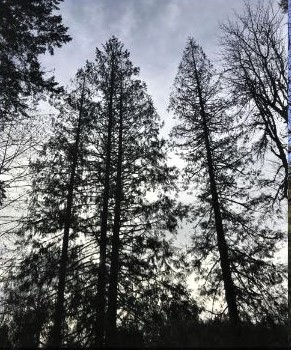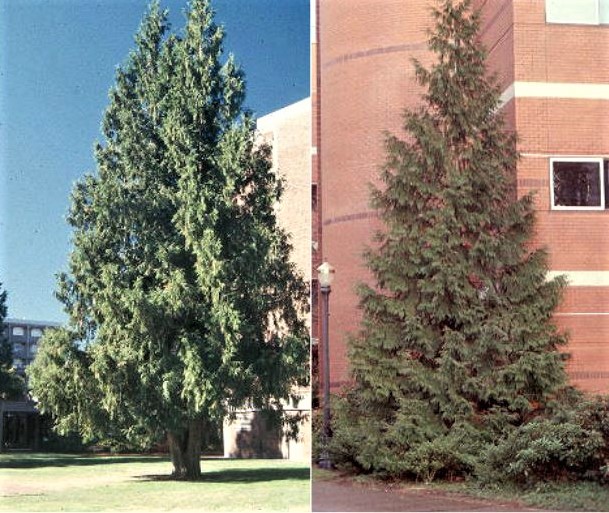Western Red Cedars Dying
Jean R. Natter, OSU Extension Master Gardener
Failing trees have been a persistent topic in MG Clinics and on the online Ask an Expert service during the past 6 or 7 years. Overall, it’s been an issue of continuing higher than normal temperatures combined with less than normal rainfall. Then, too, few homeowners realize that the continuing heat and drought affects their landscape trees in spite of being watered with the lawn sprinklers.

Fig 1 (right): Western red cedar, Thuja plicata, with thinning crowns most likely due to climate changes and continuing drought. (“Why is My Tree Dying? – Western Redcedar (Thuja plicata)” – April 2019; https://www.oregon.gov/ODF/Documents/ForestBenefits/TreeDeclinesRedcedar.pdf)
In order for trees to thrive, they should be irrigated separately from grass, with at least one watering to about 10 inches deep to the soil below the canopy every 3 weeks during our dry season. Indications of a water deficit is revealed by multiple signs and symptoms, among them wilted leaves; leaves with curled and/or dry edges; early fall color; leaf yellowing and early leaf drop.
Foresters have been puzzled by problems with Western Red Cedar (Thuja plicata) which normally do well on moist sites. The most recent thought is that these trees are finally succumbing to stress from many successive years of heat and drought stress.
Several recent Ask an Expert responses have noted “We are getting many reports of western redcedars dying this year, and the consensus seems to be that the combination of extreme heat and drought experienced since around 2013 through last summer is an important factor. Although this summer was mild, it often takes a year or so for a tree to show any signs of distress from drought.”
Another expert, in a response to a different client, said it this way: “Western redcedar are dying in some areas due to a complex of climate stress and other issues, with no clear primary agent of mortality.”

Fig 2 (right): Two healthy Western red cedars (Thuja plicata) on the Oregon State University campus, southeast of Fairbanks Hall. ( OSU Landscape Plants; https://landscapeplants.oregonstate.edu/plants/thuja-plicata)
In general, the foresters responding through Ask an Expert are including a link to a publication released in April 2019: “Why is My Tree Dying? – Western Redcedar (Thuja plicata)” which, in summary, states:
Top-dieback, branch mortality, crown thinning and whole-tree mortality in all ages of western redcedar has [sic] been observed recently at lower elevations in the Willamette Valley and beyond. Although it is common to see ‘spiked’ or dead tops in older western redcedar, usually there are living lateral branches and a functional crown. No single factor has been identified in these more recent die offs, but a combination of poor or unsustainable growing conditions may be to blame. Redcedar may simply be growing in areas or within microclimates outside of their preferred range or areas that are no longer sustainable for long-term growth under current climate conditions.
Then, too, it suggests that alternate species for red cedar on generally dry sites include incense cedar, sequoia, and big leaf maple; on more moist sites which don’t dry out in the summer, western white pine, maple, alder, ash, or cottonwood.
Resources
– Abiotic Disorders of Landscape Plants” (#3420 UCANR); pages 51-59. A copy is in each of the metro MG offices.
– “Thuja plicata (Western Red Cedar)” outlines a basic description of this native conifer (50-70 feet, or more) which thrives in sun to part shade on moist soils, with numerous images of a healthy tree. https://landscapeplants.oregonstate.edu/plants/thuja-plicata
– “Why is My Tree Dying? – Western Redcedar (Thuja plicata)” – April 2019 – https://www.oregon.gov/ODF/Documents/ForestBenefits/TreeDeclinesRedcedar.pdf
– “Pruning Drought Stressed Shade Trees” encourages caution to remove as little wood as possible from a stressed tree, in part because it already has limited reserves, with precious little remaining to “spend” on otherwise unneeded wound repair. https://droughtresources.unl.edu/droughtpruning
